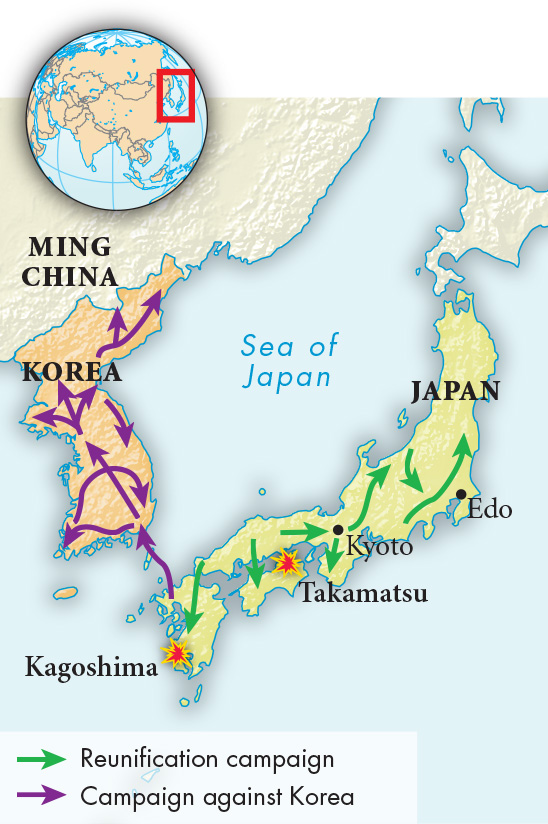The Victors: Nobunaga and Hideyoshi
The first daimyo to gain a predominance of power was Oda Nobunaga (1534–1582). A samurai of the lesser daimyo class, he recruited followers from masterless samurai who had been living by robbery and extortion. After he won control of his native province in 1559, he immediately set out to extend his power through central Japan. A key step was destroying the military power of the great monasteries. To increase revenues, he minted coins, the first government-issued money in Japan since 958. Also to raise revenues, he promoted trade by eliminating customs barriers and opening the little fishing village of Nagasaki to foreign commerce; it soon became Japan’s largest port.

Matsumoto Castle Matsumoto Castle Hideyoshi built Matsumoto Castle between 1594 and 1597. Designed to be impregnable, it was surrounded by a moat and had a base constructed of huge stones. In the sixteenth and early seventeenth centuries Spanish and Portuguese missionaries compared Japanese castles favorably to European castles of the period. (Adina Tovy/Robert Harding World Imagery)

Hideyoshi’s Campaigns in Japan and Korea, 1592–1598
In 1582, in an attempted coup, Nobunaga was forced by one of his vassals to commit suicide. His general and staunchest adherent, Toyotomi Hideyoshi (1537–1598), avenged him and continued the drive toward unification of the daimyo-held lands.
Like the Ming founder, Hideyoshi was a peasant’s son who rose to power through military talent. Hideyoshi succeeded in bringing northern and western Japan under his control. In 1582 he attacked the great fortress at Takamatsu. When direct assault failed, his troops flooded the castle to force its surrender. A successful siege of the town of Kagoshima then brought the southern island of Kyushu (KYOO-shoo) under his domination. Hideyoshi soothed the vanquished daimyo as Nobunaga had done — with lands and military positions — but he also required them to swear allegiance and to obey him down to the smallest particular. For the first time in over two centuries, Japan had a single ruler.
Hideyoshi did his best to ensure that future peasants’ sons would not be able to rise as he had. His great sword hunt of 1588 collected weapons from farmers, who were no longer allowed to wear swords. Restrictions were also placed on samurai; they were prohibited from leaving their lord’s service or switching occupations. To improve tax collection, Hideyoshi ordered a survey of the entire country. His agents collected detailed information about each daimyo’s lands and about towns, villages, agricultural produce, and industrial output all over Japan. His surveys not only tightened tax collection, but also registered each peasant household and tied the peasants to the land. With the country pacified, Hideyoshi embarked on an ill-fated attempt to conquer Korea and China that ended only with his death (see “Piracy and Japan’s Overseas Adventures”).

